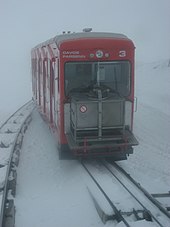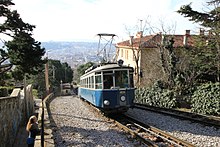Cable car
Cableway is the generic term for railways in which driving forces are transmitted to vehicles by means of ropes . The rope can be moved by stationary drive stations as well as by other vehicles on the railroad.
Sometimes the cable railway instead of skewness rope level used.
The cable cars can be divided into the following types:
Inclined rope plane
An inclined cable plane is a steeply inclined section of a larger railway network that trains can only negotiate using propulsion forces transmitted by cables. The trains are only coupled to the rope for the journey over the steep section of the route, on the subsequent routes they run in normal adhesion mode .
On the inclined plane, the rope is either moved by stationary drive machines, or the train traveling uphill is connected to the train traveling downhill with the help of a cable running over a pulley at the upper end of the route. The train going downhill can also consist of just one locomotive, so that one is more flexible in the operational sequence.
Many inclined rope levels were laid in the beginning of the railway age and initially operated without locomotives, for example for the first trains on the Stockton and Darlington Railway . As early as 1900, most of them had been dismantled and replaced by normal adhesive tracks, as the systems were complex to operate and more powerful locomotives were now available.
Examples of inclined rope levels:
- Erkrath – Hochdahl steep ramp between Düsseldorf and Wuppertal . The trains going uphill were pulled up the ramp from the trains going downhill from 1841 to 1927 by means of a rope running over three pulleys.
- The Ans bei Liège inclined plane , on the Liège-Brussels line, today the LGV line, was in operation from 1842 to 1871.
- Paranapiacaba cable car , part of the Santos – Jundiaí railway line , Brazil . 1974/82 replaced by a rack railway on the route of the first inclined cable plane.
- Cromford and High Peak Railway , a railway in Derbyshire, UK, with eight inclined levels of rope connecting two canals. Operation ceased in 1967.
- Beck Hole Ramp on the Whitby and Pickering Railway , England, 1836–1865. Has been replaced by a bypass.
Funicular

→ Main article: Funicular
Standard design / normal form
A funicular is a railway on which two cars that are permanently connected to a wire run. In the mountain station, the rope is guided over a pulley, which either has a stationary drive or is non-drive. In the latter case, the vehicles move by increasing the weight of the car going downhill due to water, as is the case with the Nerobergbahn in Wiesbaden to this day. But there are also funiculars that are driven by a second cable from the valley station.
If only one car is used, the system is considered an inclined elevator . This term is used colloquially for all such systems.
Examples of funiculars:
- Davos-Parsenn-Bahn , Switzerland
- Merkurbergbahn , Baden-Baden, Germany
- Hungerburgbahn , Austria
Funicular railway with tractor operation
In some cases, funicular railways have also been used to transport adhesion vehicles over steep ramps, with the adhesion vehicles being supported on the carriages of the funicular railway during the journey. In contrast to the inclined rope levels, the wagons of the funicular always remain connected to the rope. Such systems are called funicular railway with tractor operation,
Examples:
- Railway line Trieste – Opicina , on which the adhesion wagons are transported over a 260 ‰ ramp by means of a funicular.
- Rue Terme - Croix-Rousse in Lyon with drive in the mountain station.
Cableway

A cableway is a railway whose vehicles are moved by a stationary drive machine over a continuously rotating wire rope. The vehicles are uncoupled from the rope during the stop in the stations. One rope can move several vehicles. Cable cars were widely used as trams in North America at the end of the 19th century. Today only the San Francisco Cable Cars are in operation as a tourist attraction.
Others
Sometimes wagons or even wagon trains are moved short distances by stationary winches and ropes , for example in order to gradually feed them to a loading or unloading facility. Many freight wagons have matching double hooks on both sides and at both ends of the wagon for both directions of pull.
literature
- Walter Hefti : Cable cars all over the world. Inclined cable levels, funiculars, cable cars. Birkhäuser Verlag, Basel u. a. 1975, ISBN 3-7643-0726-9 .

